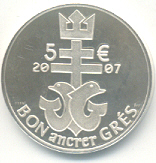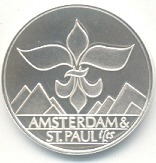 |
 |
| Îles Amsterdam & St. Paul |
|
Île Amsterdam: Not to be confused with the Arctic Amsterdam Island in the Svalbard archipelago, near the northwestern corner of Spitsbergen. New Amsterdam or Île Amsterdam (meaning Amsterdam island after the Dutch capital) is a French island in the Indian Ocean located at 37°52'S, 77°32'E. The island is volcanic but has been inactive since 1792. It has an area of 55 km² (21 mi²), measuring 21 km (13 mi) on its longest side, and reaches as high as 867 m (2844 ft) at the Mont de la Dives. The island is part of the French Southern and Antarctic Lands (Terres australes et antarctiques françaises; TAAF), and together with neighboring Île Saint-Paul (85 km to the South) forms one of the five districts of the territory. Its base Martin-de-Viviès, formerly called La Roche Gódon, is the capital of the territory. Unlike most parts of TAAF, Île Amsterdam has a mild, oceanic climate, with a mean annual temperature of 13°C (55°F}, rainfall of 1,100 mm, persistent westerly winds and high levels of humidity. Île Amsterdam is one of only three islands which are land antipodes of the continental United States. It corresponds to an area near La Junta, Colorado. The other two antipodes are île Saint-Paul and Kerguelen Island. |
|||||||||||||||||||||||||||||||
|
This island was discovered by the Spanish explorer
Juan Sebastián Elcano on March 18, 1522. Elcano did not name the island,
however. Having found the island unnamed, the Dutch captain Anthonie van
Diemen named it Nieuw Amsterdam (Dutch for New Amsterdam) after his ship
in 1633. French Captain François Péron, was marooned three years on this island. Péron had been on the French ship Emélie, which wrecked on New Amsterdam Island in 1792. In 1795 he was taken to Australia by ship Ceres. His 'Memoires', in which he describes his survival alone on New Amsterdam, were published in a limited edition and are now an expensive collectors' item. In 1871 a British frigate, HMS Megaera, was wrecked in this lonely island. Most of the 400 persons on board had to remain upwards of three months on the island. The islands of Île Amsterdam and Île Saint-Paul were attached to Madagascar in 1924 and hence became a French colony. The first French base in New Amsterdam was erected in 1949, and was originally called Camp Heurtin. The Global Atmosphere Watch still has an atmospheric research station on Île Amsterdam. |
|||||||||||||||||||||||||||||||
| The island has Phylica arborea trees, which are also found on Tristan da Cunha. The island is home to the Amsterdam Albatross, which breeds only on the Plateau des Tourbières on Île Amsterdam. The island is also home to other rare species, such as the Great Skua, the Antarctic Tern, the Gentoo penguin, the Subantarctic Fur Seal and the Elephant seal. The only existing herd of completely wild Cattle also lives on the island. | |||||||||||||||||||||||||||||||
|
Île Saint-Paul (St. Paul Island): Not to be confused with Saint Paul Island, Alaska or St. Paul Island, Nova Scotia. It is a very small island forming part of the French Southern and Antarctic Lands (France) in the Indian Ocean. It is about 85 kilometres (53 miles) south of the larger île Amsterdam, located at 38°43'19?S, 77°31'44?E. It is a rocky and uninhabited island measuring no more than five km (three miles) at its greatest width and is completely devoid of trees. A scientific research cabin on the island is used for scientific or ecological short campaigns, but there is no permanent population. |
|||||||||||||||||||||||||||||||
|
Île Saint-Paul is one of three islands which is an
antipode of the United States. It corresponds to Firstview, Colorado.
The other two antipodes are île Amsterdam and Kerguelen Island. In the 1880s Charles Lightoller was shipwrecked here. He accurately describes the island in his autobiography, Titanic and Other Ships. During French rule of Mauritius, Saint-Paul as well as île Amsterdam were administered from Port Louis, but they were transferred to Réunion prior to British invasion of Mauritius. In 1871 a British frigate, HMS Megaera, was wrecked in this lonely island. Most of the 400 persons on board had to remain upwards of three months on the island. In 1928, an ill-fated spiny lobster cannery was established on Île Saint-Paul. Seven employees of the cannery were abandoned to their fate on the island when the company went bankrupt in 1931; they later came to be known as Les Oubliés de Saint-Paul ("the forgotten ones of St. Paul"). Five died; the two survivors were finally rescued in 1934. |
|||||||||||||||||||||||||||||||
| As usual Mr. Fred Richard Zinkann has produced pattern / trial coins on the name of Îles Amsterdam & St. Paul in various metals. The text "BON ancrer GRES" is shown on these coins. Below are their details with mintage. | |||||||||||||||||||||||||||||||
|
|||||||||||||||||||||||||||||||
 |
 |
||||||||||||||||||||||||||||||
| I got my 5 Euros with 25mm diameter with 2mm thickness coin in .999 Silver from Elizabeth Anne Zinkann (ezinkann@comcast.net). | |||||||||||||||||||||||||||||||
| Micro-Nations | |||||||||||||||||||||||||||||||
| Chiefa Coins | |||||||||||||||||||||||||||||||